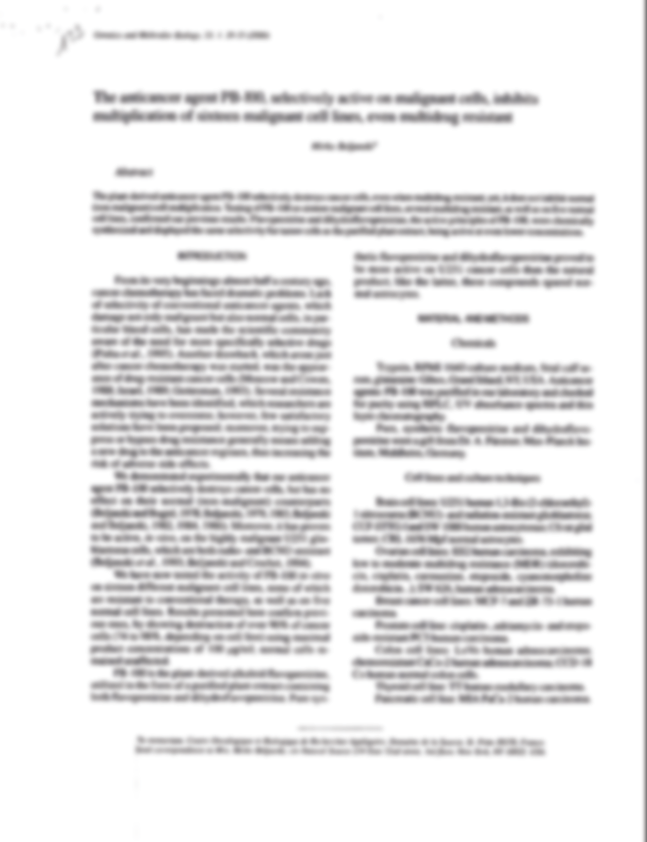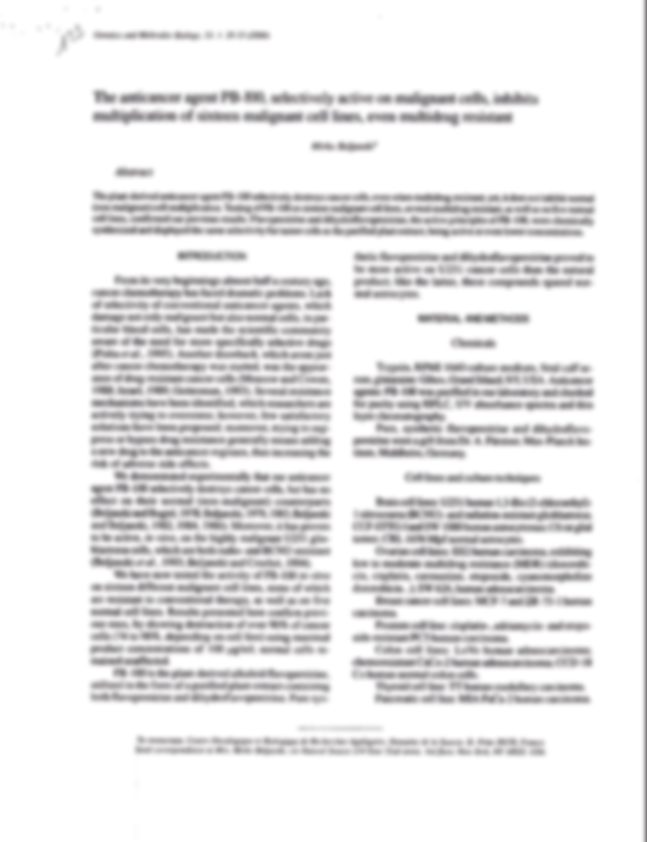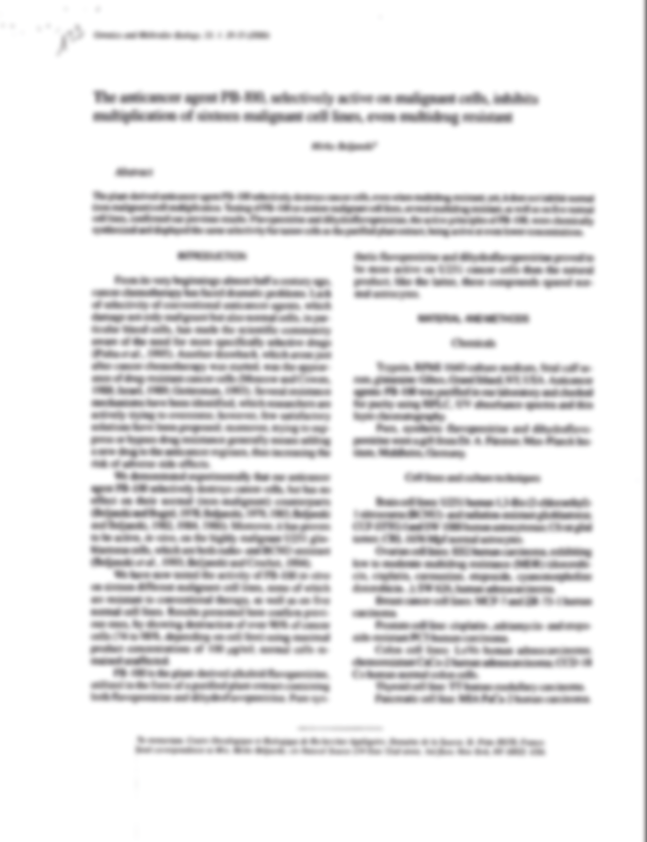113 – Reversible biophysical changes of DNAs from in vitro cultured non-tumour cells
Med. Sci. Res., 16, 1988, pp. 359-361.
Available in English only
ABSTRACT: We have previously shown that DNA fom plant Crown-gall tumour tissues is highly relaxed and thereby very susceptible to various DNA-destabilizing agents which, in contrast, do not affect DNA from healthy tissues. In vitro DNA strand separation (chain unpairing), the rate of in vitro DNA synthesis and in vivo increase in tumor cell multiplication are colsely correlated. Here we report that plant non-tumour cell DNA may temporarily undergo conformational changes when these cells are cultured in vitro in the presence of opines (octopine, nopaline, lysopine which accumulate in Crown-gall tissues or dl-ethionine (a known carcinogen in mammalian tissues). The induced DNA double-strand destabilisation and consequent increase in template activity are shown to be reversible under our experimental conditions.
ABSTRACT: We have previously shown that DNA fom plant Crown-gall tumour tissues is highly relaxed and thereby very susceptible to various DNA-destabilizing agents which, in contrast, do not affect DNA from healthy tissues. In vitro DNA strand separation (chain unpairing), the rate of in vitro DNA synthesis and in vivo increase in tumor cell multiplication are colsely correlated. Here we report that plant non-tumour cell DNA may temporarily undergo conformational changes when these cells are cultured in vitro in the presence of opines (octopine, nopaline, lysopine which accumulate in Crown-gall tissues or dl-ethionine (a known carcinogen in mammalian tissues). The induced DNA double-strand destabilisation and consequent increase in template activity are shown to be reversible under our experimental conditions.
112 – Iron stimulated RNA-dependent DNA polymerase Activity from goldfish eggs
Cellular and Molecular Biology, 34, 1988, pp. 17-25.
Document not available online
Document not available online
111 – Particular RNA primer from growth medium differentially stimulates in vitro DNA synthesis and in vivo cell growth of Neurospora crassa and its slime mutant
Current Genetics, 12, 1987, pp. 283-289
Available in English only
ABSTRACT: Purine rich small “RNA-primer” molecules (about 10-12 nucleotides), secreted into the growth medium of 3-h germinated conidia of N. crassa, strongly stimulated a concentration-dependent in vitro DNA synthesis of N. crassa slime mutant as well as DNAs from the human cancer cells but did not affect that from normal cells. These “RNA-primer” molecules stimulated also in vivo cell growth of N. crassa slime mutant, but not of the N. crassa wild type. Our studies suggest that DNAs from the slime mutant of N. crassa as well as DNAs from human cancerous cells provide increased sites for enhanced in vitro and in vivo replication of DNAs. “RNA-primer” molecules can be hydrolyzed by T1 RNase but not by pancreatic RNase.
ABSTRACT: Purine rich small “RNA-primer” molecules (about 10-12 nucleotides), secreted into the growth medium of 3-h germinated conidia of N. crassa, strongly stimulated a concentration-dependent in vitro DNA synthesis of N. crassa slime mutant as well as DNAs from the human cancer cells but did not affect that from normal cells. These “RNA-primer” molecules stimulated also in vivo cell growth of N. crassa slime mutant, but not of the N. crassa wild type. Our studies suggest that DNAs from the slime mutant of N. crassa as well as DNAs from human cancerous cells provide increased sites for enhanced in vitro and in vivo replication of DNAs. “RNA-primer” molecules can be hydrolyzed by T1 RNase but not by pancreatic RNase.
110 – Differential Synthesis and Replication of DNA in the Neurospora crassa Slime Mutant versus Normal Cells: Role of Carcinogens
Oncology, 44, 1987, pp. 327-330
Available in English only
ABSTRACT: Small quantities of carcinogens, dl-ethionine, thiotepa, actinomycin D, and 1-(2-chloroethyl-3-cyclohexyl)-1-nitrosourea (CCNU) stimulated in vitro deoxyribonucleic acid (DNA) synthesis of the slime mutant of Neurospora crassa, while there was practically no effect on the DNA from the normal wild type 74A strain. All of these compounds caused increased strand separation in the mutant DNA of N. crassa, but no separation of normal DNA strands. The growth (in vivo tests) of the N. crassa slime mutant, but not its wild type, was markedly increased when nontoxic concentrations of one of the carcinogens (dl-ethionine) tested were present in the growth medium. These observations suggest that, unlike the wild type N. crassa, the slime mutant allows an excessive and unscheduled replication, indicating destabilized nature of its DNA.
ABSTRACT: Small quantities of carcinogens, dl-ethionine, thiotepa, actinomycin D, and 1-(2-chloroethyl-3-cyclohexyl)-1-nitrosourea (CCNU) stimulated in vitro deoxyribonucleic acid (DNA) synthesis of the slime mutant of Neurospora crassa, while there was practically no effect on the DNA from the normal wild type 74A strain. All of these compounds caused increased strand separation in the mutant DNA of N. crassa, but no separation of normal DNA strands. The growth (in vivo tests) of the N. crassa slime mutant, but not its wild type, was markedly increased when nontoxic concentrations of one of the carcinogens (dl-ethionine) tested were present in the growth medium. These observations suggest that, unlike the wild type N. crassa, the slime mutant allows an excessive and unscheduled replication, indicating destabilized nature of its DNA.
109 – Terminal deoxynucleotidyl transferase and ribonuclease activities in purified hepatitis-B antigen
Med. Sci. Res., 15, 1987, pp. 529-530.
Available in English only
ABSTRACT: Terminal deoxyribonucleotidyl transferase (TdT) (EC 2.7.7.31) was defined as a template independent DNA polymerase that binds deoxyribonucleoside-5′-monophosphates (dNMP) in sequential addition to the 3’OH end of the DNA initiator. TdT may exhibit its activity in the presence of oligodeoxyribopolymers. This enzyme has been found in embryonic calf thymus gland, cortical thymocytes, brain, primitive bone marrow cells, peripheral blood lymphocytes in certain forms of acute leukemia, neuroblastoma and retroviruses. A model was proposed according to which TdT may generate somatic mutations in the variable region of immunoglobulin genes. Recently, the mutagenic potential of TdT has been evaluated: TdT inserts noncomplementary bases during repair synthesis by DNA polymerase. The present work shows that purified and commercially available hepatitis-B antigen (vaccine) contains a very active TdT and ribonuclease (RNase).
ABSTRACT: Terminal deoxyribonucleotidyl transferase (TdT) (EC 2.7.7.31) was defined as a template independent DNA polymerase that binds deoxyribonucleoside-5′-monophosphates (dNMP) in sequential addition to the 3’OH end of the DNA initiator. TdT may exhibit its activity in the presence of oligodeoxyribopolymers. This enzyme has been found in embryonic calf thymus gland, cortical thymocytes, brain, primitive bone marrow cells, peripheral blood lymphocytes in certain forms of acute leukemia, neuroblastoma and retroviruses. A model was proposed according to which TdT may generate somatic mutations in the variable region of immunoglobulin genes. Recently, the mutagenic potential of TdT has been evaluated: TdT inserts noncomplementary bases during repair synthesis by DNA polymerase. The present work shows that purified and commercially available hepatitis-B antigen (vaccine) contains a very active TdT and ribonuclease (RNase).
108 – Régulation des gènes, cancer et prévention
Médecines nouvelles, 15, 1986, pp. 57-86.
Document not available online.
Document not available online.
107 – Possible role of markers synthesized during cancer evolution: II- Markers in crown-gall tissues
IRCS Med. Sci. 14, 1986, pp. 811-812
Document not available online
Document not available online
106 – Possible role of markers synthesized during cancer evolution: I- Markers in mammalian tissues
IRCS Med. Sci. 14, 1986, pp. 809-810.
Available in English only
ABSTRACT: Various trigger molecules (carcinogens, antimitotics, antibiotics, hormones, etc…) may induce mammalian cancer DNA chain relaxation correlated with an in vitro increase of DNA synthesis and the enhancement of cancer cell multiplication in vivo. In contrast, particular substances which contract cancer DNA chains inhibit cancer DNA synthesis and prevent cancer cell multiplication in vivo. During cancer evolution, large amounts of α-feto-protein (AFP), carcinoembryonic antigen (CEA) and calcitonin, may be synthesized. AFP normally produced by liver cells may accumulate in breast cancer tissues or in induced inflammatory lesions; it favours the accumulation of estrone in the new-born rat brain and affects the multiplication of estrogen-sensitive cells. The aim of the present work was to determine the effect of some embryonic antigens (markers) on normal and cancer DNA chain relaxation and DNA in vitro synthesis, in order to investigate their participation in the maintenance of the neoplastic state in vivo.
ABSTRACT: Various trigger molecules (carcinogens, antimitotics, antibiotics, hormones, etc…) may induce mammalian cancer DNA chain relaxation correlated with an in vitro increase of DNA synthesis and the enhancement of cancer cell multiplication in vivo. In contrast, particular substances which contract cancer DNA chains inhibit cancer DNA synthesis and prevent cancer cell multiplication in vivo. During cancer evolution, large amounts of α-feto-protein (AFP), carcinoembryonic antigen (CEA) and calcitonin, may be synthesized. AFP normally produced by liver cells may accumulate in breast cancer tissues or in induced inflammatory lesions; it favours the accumulation of estrone in the new-born rat brain and affects the multiplication of estrogen-sensitive cells. The aim of the present work was to determine the effect of some embryonic antigens (markers) on normal and cancer DNA chain relaxation and DNA in vitro synthesis, in order to investigate their participation in the maintenance of the neoplastic state in vivo.
105 – Analysis of small RNA species: phylogenetic trends
In DNA Systematics, vol.I: Evolution. Ed. S.K. Dutta CRC Press, Inc. Florida (1986), pp. 81-105.
Document not available online
Document not available online
104 – Three Alkaloids as Selective Destroyers of Cancer Cells in Mice. Synergy with Classic Anticancer Drugs
Oncology, 43, 1986, pp. 198-203
Document not available online
Document not available online






